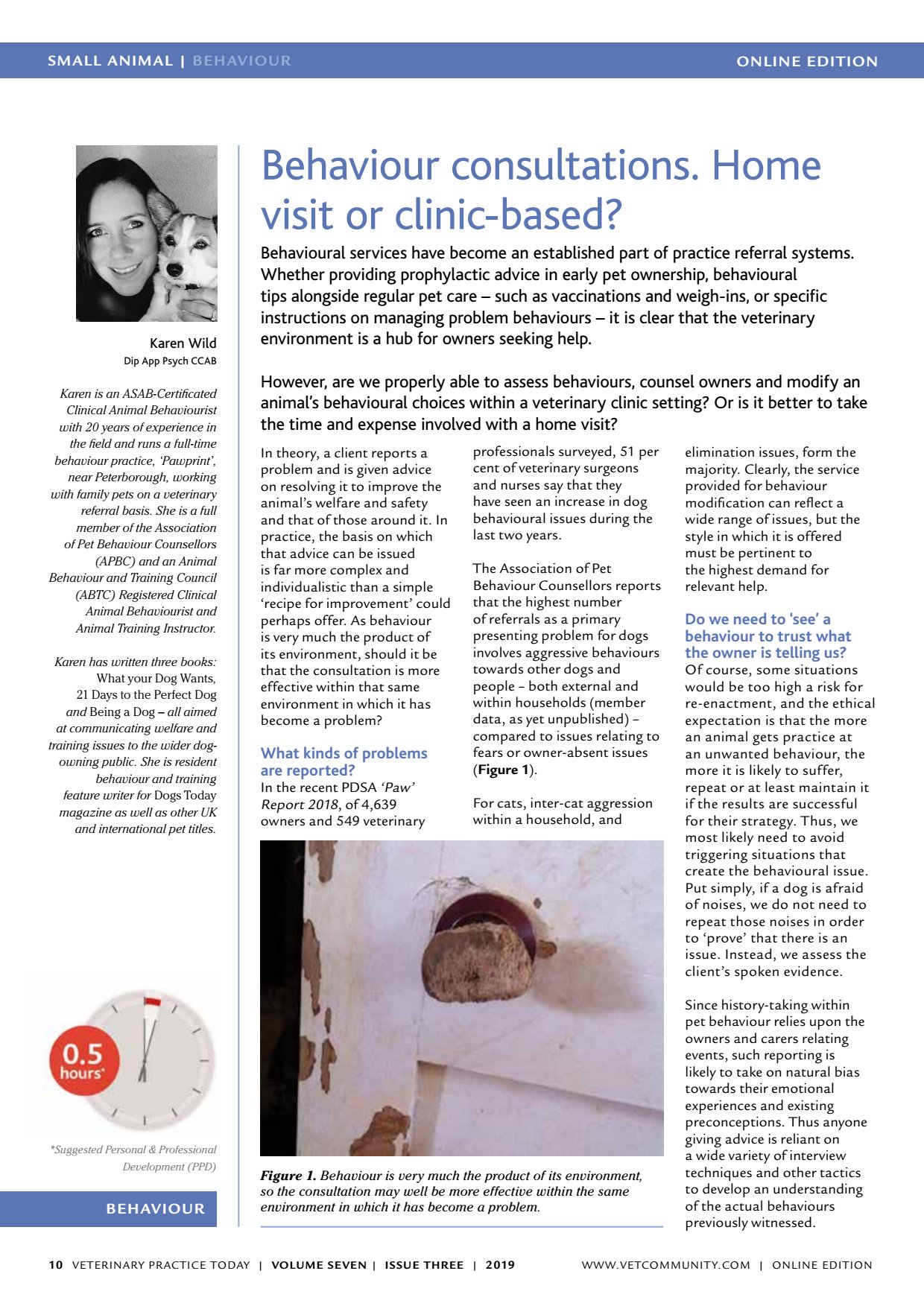What kinds problems
ONLINE EDITIONSMALL ANIMAL | BEHAVIOUR VETERINARY PRACTICE TODAY | VOLUME SEVEN | ISSUE THREE | 2019 10 BEHAVIOUR Suggested Personal & Professional Development (PPD) Behaviour consultations. Home visit or clinic-based? Behavioural services have become an established part of practice referral systems. Whether providing prophylactic advice in early pet ownership, behavioural tips alongside regular pet care such as vaccinations and weigh-ins, or specific instructions on managing problem behaviours it is clear that the veterinary environment is a hub for owners seeking help. However, are we properly able to assess behaviours, counsel owners and modify an animals behavioural choices within a veterinary clinic setting? Or is it better to take the time and expense involved with a home visit? In theory, a client reports a problem and is given advice on resolving it to improve the animals welfare and safety and that of those around it. In practice, the basis on which that advice can be issued is far more complex and individualistic than a simple recipe for improvement could perhaps offer. As behaviour is very much the product of its environment, should it be that the consultation is more effective within that same environment in which it has become a problem? What kinds of problems are reported? In the recent PDSA Paw Report 2018, of 4,639 owners and 549 veterinary professionals surveyed, 51 per cent of veterinary surgeons and nurses say that they have seen an increase in dog behavioural issues during the last two years. The Association of Pet Behaviour Counsellors reports that the highest number of referrals as a primary presenting problem for dogs involves aggressive behaviours towards other dogs and people both external and within households (member data, as yet unpublished) compared to issues relating to fears or owner-absent issues ( Figure 1 ). For cats, inter-cat aggression within a household, and elimination issues, form the majority. Clearly, the service provided for behaviour modification can reflect a wide range of issues, but the style in which it is offered must be pertinent to the highest demand for relevant help. Do we need to see a behaviour to trust what the owner is telling us? Of course, some situations would be too high a risk for re-enactment, and the ethical expectation is that the more an animal gets practice at an unwanted behaviour, the more it is likely to suffer, repeat or at least maintain it if the results are successful for their strategy. Thus, we most likely need to avoid triggering situations that create the behavioural issue. Put simply, if a dog is afraid of noises, we do not need to repeat those noises in order to prove that there is an issue. Instead, we assess the clients spoken evidence. Since history-taking within pet behaviour relies upon the owners and carers relating events, such reporting is likely to take on natural bias towards their emotional experiences and existing preconceptions. Thus anyone giving advice is reliant on a wide variety of interview techniques and other tactics to develop an understanding of the actual behaviours previously witnessed. Karen Wild Dip App Psych CCAB Karen is an ASAB-Certificated Clinical Animal Behaviourist with 20 years of experience in the field and runs a full-time behaviour practice, Pawprint, near Peterborough, working with family pets on a veterinary referral basis. She is a full member of the Association of Pet Behaviour Counsellors (APBC) and an Animal Behaviour and Training Council (ABTC) Registered Clinical Animal Behaviourist and Animal Training Instructor. Karen has written three books: What your Dog Wants , 21 Days to the Perfect Dog and Being a Dog all aimed at communicating welfare and training issues to the wider dog- owning public. She is resident behaviour and training feature writer for Dogs Today magazine as well as other UK and international pet titles. Figure 1. Behaviour is very much the product of its environment, so the consultation may well be more effective within the same environment in which it has become a problem. WWW.VETCOMMUNIT Y.COM | ONLINE EDITION
